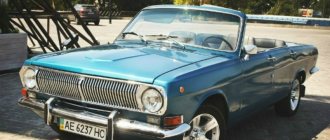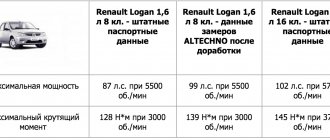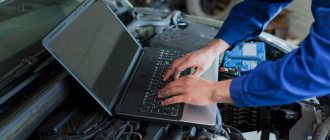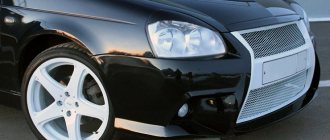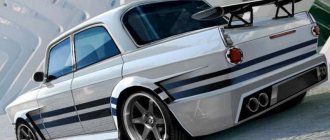Today, every car enthusiast is familiar with the concept of chip tuning. Literally this means “chip tuning”. As you know, modern engines have an electronic control system that fully controls fuel injection, ignition and the operation of other internal combustion engine systems.
This setting involves making certain changes to the control program, which is “hardwired” into the ECU memory. A complete replacement of the program with a modified one can also be implemented. In some cases, it is practiced separately to install additional modules (the so-called chip and tuning boxes).
Engine chipping promises the owner an increase in power, increased acceleration dynamics, elasticity of the internal combustion engine and a number of other improvements at a relatively low price. Moreover, there is no need to physically modify the power unit, that is, the engine does not need to be disassembled and any parts and elements installed for such boosting.
It would seem that this method is a well-known and affordable solution, but not everyone thinks about whether chip tuning is harmful to the engine. In this article we intend to talk about how engine chipping affects the internal combustion engine, the consequences of such an operation, and also why for many civilian cars there is no need for such modification in practice.
Skills come first
Do-it-yourself engine tuning is not possible for those who do not have the skills to service and repair it. Without any technical knowledge, there is no need to do this.
Moreover, in some respects, engine tuning is much more complicated than ordinary repairs, since it requires an integrated approach to any reconstruction.
This is especially true for engine chip tuning, where the requirements for a specialist must be very strict.
These events, first of all, are carried out for a specific purpose, which is obvious to many car enthusiasts - to improve its technical characteristics. Since such work is not cheap, many try to do engine tuning themselves.
Ignition system modernization
By upgrading the ignition system, you can get about a dozen additional horsepower without any reduction in service life.
In this case, we can recommend that you use ready-made ignition systems, which will significantly simplify the work being carried out.
In specialized stores, car owners can find ready-made blocks for changing the ignition system. You can choose an option designed for a specific car, which will allow you to carry out everything as efficiently as possible and without loss of engine reliability.
If you have some experience, you can perform such tuning of the ignition system yourself, which will allow you to save on using the services of professional mechanics.
At the same time, you need to calculate the increased power as accurately as possible and determine whether the exhaust system or engine power components will need to be replaced.
What you need to understand
But before you start such work, you must understand that an engine is a device in which everything is interconnected, and by changing something in one, you can affect another more important one.
Changing loads under different engine operating modes can lead to irreparable consequences.
The main thing that experts strive to influence in the process of engine tuning is:
- Increase its power;
- Increased torque.
And this is natural, since these are the main components of the engine that affect the operation of the car.
This is usually achieved in two ways:
- Increase engine torque directly at the crankshaft;
- Without increasing the torque on the crankshaft, the engine is transferred to the high speed sector.
Results
As you understand, there are many ways that can increase engine power, but easy methods will not give good results, and refinement methods that give good results require complex work and additional improvements. You must understand that all parts of the car are calculated approximately for its entire components. That is, the gearbox and suspension are able to withstand all the data and most often have a small margin, but the manufacturer will not do this for a 100 hp engine. A gearbox capable of withstanding 1000 hp does not make sense. Therefore, if you decide to seriously tune your power plant and achieve high performance, then your task, firstly, is not to stop at one method, but to use everything, and secondly, to improve the stability of the gearbox, suspension and engage in engine cooling.
In this article we have listed the most basic and most popular methods of engine tuning, and we hope that we have answered your question in sufficient detail. Of course, there are still different ways to modify the motor, but they are rarely used for certain reasons. If you think that we have missed some method, then write to us by email and we will add this method to the article, also share the article with your friends and love your cars.
Increased torque
Increasing torque is achieved in three ways.
First way.
The first method uses engine characteristics such as its volume and cylinder pressure.
If you delve into the deep knowledge of the internal combustion engine, you can remember that the torque itself, as many people think, is in no way dependent on the crankshaft speed.
Its performance is directly affected by engine displacement and cylinder pressure, which we discussed above.
Naturally, the larger the engine volume we achieve, the greater the torque will be. But here everything depends on the design of the engine itself.
Pressure is a little more difficult. It can be increased by increasing the compression ratio, which in turn depends on detonation.
Or force as much of the air-fuel mixture into the engine as possible, which, one might assume, will release much more heat and generate greater pressure.
Obviously, the use of this method is more typical only for atmospheric engines.
Second way.
The second method is easier to understand and is typical for turbocharged engines. Due to the fact that in such engines it is possible to change the amount of boost, increasing it, it will be possible to increase the torque of the engine crankshaft.
Third way.
The third method is the most common, but this does not mean that it is the most successful. With this method, the combustion chamber and the channels supplying the combustible mixture are changed.
Nitrous oxide
Kit for installing nitrous oxide
In cases where an increase in power and torque is required only for a short period of time, a simpler alternative to mechanical tuning is used - nitrous oxide N2O (nitros). Nitros is the best choice for those who do not want to spend a lot of money, but still want to achieve a significant increase in engine power.
Mechanical tuning implies direct mechanical intervention in the operation of the engine, alteration of its components and assemblies. This, in turn, reduces engine life or leads to very expensive replacements of parts such as cylinder blocks, pistons, connecting rods, crankshafts, camshafts, valves, etc. The nitrooxide system (NOS) is turned on at the driver's request, and the rest of the time the engine operates in its normal mode without additional loads and fuel consumption.
Where does the increase in power come from? The density of nitrous oxide is approximately 50% greater than the density of air. Oxygen in it is about 36% (versus 21% in the atmosphere). That is, during the decomposition of nitrous oxide, 1.7 times more oxygen is released than is found in the same volume of air. To supply the portion of nitrous oxide necessary for instant acceleration into the cylinders, you do not need a turbine or a drive compressor - it is enough to let the liquefied gas from the cylinder into the intake manifold. This is what they do during acceleration by opening the gas line valve using a remote drive.
Once in the engine, nitrous oxide molecules break down into nitrogen and oxygen under the influence of high temperatures, and this released oxygen allows gasoline to burn more efficiently. The pressure in the cylinder increases, and as a result, an increase in power. And the released nitrogen works as an anti-knock agent, preventing the combustion process from proceeding like an avalanche.
Nitrous oxide also increases the density of the air-fuel mixture. Nitrous oxide supplied to the mixture in the form of liquefied gas leads to its immediate cooling, because the temperature of the evaporating liquefied gas is always several orders of magnitude lower than the ambient temperature. And as we know, a cooler, denser mixture burns better and produces more power.
Types of Nitrous Oxide Systems
There are three types of nitrous oxide systems – the so-called “dry”, “wet”, and direct port systems.
- The “dry” system is the cheapest and simplest; nitrous is supplied to the manifold by one nozzle. The system is uncontrollable; it can only be turned on and off. An additional nozzle for supplying nitrous is embedded under the carburetor or into the manifold behind the air filter (for injection engines). Fuel injection is carried out as usual. That's the problem. When supplying nitrous oxide, you need to supply more fuel. Otherwise, the mixture will become leaner, and unwanted detonation will occur, which may well lead to engine failure. And since the injection is controlled by the on-board computer, you have to either reconfigure it, increasing the duration of opening of the injectors, or increase the pressure in the fuel line.
- The “wet” nitros system is a more advanced device. Nitrous is supplied in the same way as in a “dry” one, but additionally fuel is supplied using a separate nozzle, which allows you to avoid detonation and achieve maximum performance for this type of injection. The volume of nitrous oxide and fuel is adjusted by the nitro system computer, which makes this device more independent and easy to control. The only difficulty is that such a system has to be connected to an additional fuel line. Such systems are especially suitable for supercharged engines.
- The third type of nitrous oxide injection systems is direct injection systems. Here, a separate nozzle is provided for each cylinder, which, at the command of the distribution block, mixes and measures the required amount of nitrous oxide and fuel. Thus, it is possible to control the nitrous oxide/fuel ratio for each cylinder individually. This is the most powerful and one of the most accurate types of systems. Direct injection systems are also the most difficult to install. Due to this, as well as their high power, these systems are mainly used on racing cars.
All these joys are overshadowed by some risk. All the scary stories about melted pistons and burned out engines are backed up by facts. As long as you install a relatively low-power NOS (nitrooxide system), there is nothing to fear. The main thing is to choose the right kit for a given engine. 4-cylinder engines allow you to get an additional 40-60 hp, 6-cylinder engines allow you to get an increase in the range of 75-100 hp, a small block V8 - up to 140 hp, a large block V8 - 200 hp. With. This is the recommended increase in power, allowing you to leave the engine mechanics without modification.
If this is too little for you, then you will need to tune the engine quite a bit. First - replacing the connecting rod and piston group. It is necessary to use forged pistons instead of stock ones due to the increased load on the engine. Next comes replacing the crankshaft and adjusting the ignition system. It is also necessary to use high-quality fuel or special racing gasoline. Often a larger fuel pump and cooler spark plugs are required.
Increase in engine displacement
Engine displacement is usually increased in two ways.
First way.
It consists of replacing the engine crankshaft with another one with a large eccentricity (a numerical indicator of the conical section, which shows the degree of its deviation from the circle).
Second way.
Another method is more prosaic; it is necessary to bore the engine cylinders for larger pistons.
So which way is better in terms of saving money?
To be honest, these two methods are expensive in themselves. The question is how much more expensive is one method than the other, and which method is more convenient and practical. And also what kind of engine you are going to tune.
Each method has its own pitfalls that are worth talking about.
General recommendations
- Before you start modifying the engine, decide on specific tasks, since tuning costs are practically unlimited
- Before purchasing improved spare parts, be sure to consult with specialists
- If you decide to tune, do everything at once - it will be cheaper
- While the engine is removed, put the sealing and fastening elements in order: if necessary, replace the gaskets and cylinder head bolts
- Handle the engine carefully and carefully after tuning, do not neglect the advice of the experts, change the oil on time
Remember that in some cases, replacing the engine with a new one with better characteristics is more advisable than modifying the old one.
Crankshaft replacement
The difficulty is that it is very difficult to find a crankshaft with a large eccentricity that will suit your engine, but if you try, it can be done.
Their production is expensive, few people make them and only to order. Therefore, in this case, it is better to buy a standard crankshaft and select pistons and connecting rods for it.
Of course, these are additional costs, because a new piston group and connecting rods are not cheap, and you still need to find them. But if you want to do engine tuning yourself, you will have to fork out some money. And whoever seeks will always find.
However, the first pitfall immediately appears. Short connecting rods, which we will have to place on the crankshaft with a large eccentricity, during operation form a larger breaking angle relative to the axis of movement, and accordingly they are pressed harder against the cylinder wall.
And here the chain of thoughts should be clear to you. They press harder, the coefficient of friction increases, and the resistance to piston movement increases. Due to the fact that the load on the short connecting rod is greater, the reliability of this design is questionable.
However, for fans of their business who do not pay attention to such trifles, this is not a problem. This method is worthy of “living” and is successfully used to increase cylinder volume when tuning an engine.
Take care of the transmission and engine attachments
photo: flickr.com
Often, oddly enough, the main pitfalls are often hidden here. Just because an engine can handle chip tuning well doesn't mean other components can handle performance as well.
For example, auxiliary components of the engine may begin to fail: the turbine (or it will not be able to pump enough air into the engine), injectors (they may also fail or work in extreme conditions after changing the firmware), and so on. All this can cause a chain reaction: overheating of the pistons, particulate filter, broken catalyst, and so on.
In addition, there is a risk of damage to the gearbox or clutch failure.
Increase in engine displacement
This method can be implemented by increasing the diameters of the cylinders, and this is also an interesting method and, at first glance, less expensive.
It is no secret for a professional motorist that almost all engines have sufficient cylinder walls to bore them by 1.2 mm. The usual width of the cylinder wall is seven or eight millimeters, which is quite enough for boring.
The positive thing about this is that it can be used with serial piston groups.
But once again, you can note that it is impossible to talk about which method is cheaper, since the cost of work depends on many factors, and one of them is the brand of your car’s engine.
How to do chip tuning yourself?
Having found out the cost of the procedure, a logical question arises: “Is it possible to do chip tuning yourself, what is needed for this and how long will it take?”
Answering the question about time costs, it should be noted that for professionals the whole process takes a little more than 10 minutes. Chip tuning, in essence, is the transfer of new parameters from the computer to the control unit.
For a beginner, the procedure may take much longer, but considering the savings, it is worth it.
Turbocharged engines
Tuning engines of this type, although much easier than those described above, still has its own characteristics. In this case, we do not have to disassemble the engine and increase the cylinder volume or change the crankshaft.
Here it will be enough for us to simply increase the amount of boost. The basis of this method lies in the ability to control the operation of the compressor, no matter what type it is.
How it all happens.
We all know that the operation of any type of compressor directly depends on the engine speed. The amount of air pressure that the compressor produces is directly proportional to the engine speed. But the pressure cannot be infinite and must be regulated.
To regulate it, there is a special control unit that releases excess pressure. By adjusting this control unit, we can achieve that the maximum pressure at which air bleeding occurs will be higher.
It follows that the fuel-air mixture will enter the cylinder under greater pressure and fill a larger volume than with the standard settings of the compressor control unit.
However, all this must be done within reasonable limits, since the engine is technologically built into a certain margin of safety, but it is not unlimited. But if you decide to go beyond a reasonable strength limit, you will need to make more serious changes to the engine design so that it does not fail.
Such changes include changing the cooling system, increasing the combustion chambers in the cylinders, working on increasing the degree of engine cooling, installing additional air intakes, etc.
It may even be necessary to replace the cast-iron crankshaft with a steel one, and install pistons that are stronger than the ones that were installed. In general, the pockets will have to be turned out completely.
From theory to practice
So, we have found out the basic principles. Let's now try to choose a scheme according to which we can boost the engine. Obviously, the first thing to decide is how much to increase the volume of the cylinders. If the goal is to achieve maximum effect when boosting, then volume cannot be neglected, even if we do not have many possibilities at our disposal: increasing power and torque is directly proportional to the volume of the cylinders. The next most important thing is the valve timing.
It is necessary to make a choice: are we “building” a “high-speed” engine that will “spin” at high speeds, or a “torque” one that will operate at medium speeds. This no doubt depends on the driver's temperament and riding style. At this stage, we have to select a camshaft for our engine - it is the shaft parameters that determine the nature of the change in torque and power based on the crankshaft rotation speed. All tuning camshafts can be divided into two groups: low and high. Based on the name, the former increase the torque in the low engine speed range, and the latter – in the high speed range. This is achieved by changing the lift height and profile of the cams, as well as the opening/closing phases of the valves.
The lower shafts have a low lift height and no valve overlap zone, which prevents the mixture from being thrown back into the intake at low speeds. Reducing the lift height entails an inevitable loss of filling at high speeds, which leads to a decrease in the maximum engine power. However, this is not so important, since their main area of application is driving around the city. The main advantage of such shafts is an increase in low-end torque, which allows you to accelerate noticeably faster from a traffic light and avoid having to downshift once again.
Top shafts, on the contrary, have wide phases, high lifts and a fairly large valve overlap area. This makes it possible to increase filling at the top, both due to an increase in the flow area in the valve area, and through the use of the inertial boost effect. At the same time, engine power almost always increases, and the peak torque shifts to a higher speed zone. Wide phases lead to the mixture being pushed back into the intake manifold at low speeds, which causes a decrease in filling and a dip at the bottom. The higher the camshaft, the stronger this effect.
Split gear
It is also recommended to install the so-called split gear - a Werner pulley, which allows, without changing the belt tension, to shift the valve timing, that is, the opening and closing moments of the intake and exhaust valves with high accuracy, while a standard gear allows you to do this with an accuracy of one tooth, which is not enough to get a good result.
Then all components and parts of the engine are “adjusted” to the engine size, but most importantly, to match the selected camshaft. In other words, the entire valve mechanism, intake and exhaust channels, cylinder-piston group - everything is “adapted” to the characteristics of the camshaft. Whatever engine the result turns out to be, it will be a new, different engine. And they need to be managed differently. That is, in a different way, but accurately regulate the composition of the fuel-air mixture and the ignition timing. Therefore, the next stage of work is setting up the engine control system (chip tuning). Without this, the new engine will not only not “give out” all its capabilities, but may lose to its standard counterpart. This is especially true for engines with electronic fuel injection systems. (More about chip tuning).
In addition, tuning the engine will inevitably entail a number of activities, such as working with the transmission, suspension, and brakes. Theoretically, and practically, engine power can be increased quite significantly, but the question is whether this measure is reasonable, because sooner or later the car itself will structurally cease to correspond to its power unit. There is a certain limit that limits the weight distribution of a car, the coefficient of adhesion of its tires to the road. There is simply no point in revving up the engine and, as a result, simply firing the clutch, burning rubber and crumbling CV joints.
What factors affect egg weight
The main influence on the size (and, accordingly, weight) of eggs is exerted by:
- breed;
- age;
- feed;
- season;
- climate.
| Productivity direction | Chicken breeds | Egg production, pcs./year | Weight, g |
| Egg | Ushanka | 160 | 55 |
| Russian white | 230-240 | 60 | |
| Leghorn | 250-300 | 57-62 | |
| Loman Brown | 300-320 | 63-64 | |
| Hisex | 310-350 | 60-70 | |
| Minorca | up to 200 | up to 80 | |
| Meat and eggs | Araucana | 180 | 58 |
| Andalusian | 160-180 | 55-62 | |
| Moscow | 180 | 62 | |
| New Hampshire | 180 | 63 | |
| Kuchinskaya | 170 | 65 | |
| Plymouth Rock | 160 | 60 | |
| Barbezier | 160-200 | 68-70 |
It has been statistically established that chickens from the first group lay eggs more often than those from the second, and almost twice as much as meat layers. Egg-bearing breeds begin laying eggs at 6 months of age and do so for approximately 10 years. But most of all they rush in the first year of life and during this time they bring more than 250 units of product. With age, indicators decrease by 10-15% per year.
Note! In the cold season, egg production is lower, and a warm climate helps to increase it
